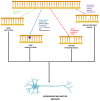Neurodegenerative disorders: Assessing the impact of natural vs drug-induced treatment options
- PMID: 36911087
- PMCID: PMC10000287
- DOI: 10.1002/agm2.12243
Neurodegenerative disorders: Assessing the impact of natural vs drug-induced treatment options
Abstract
Neurodegenerative illnesses refer to the gradual, cumulative loss of neural activity. Neurological conditions are considered to be the second leading cause of mortality in the modern world and the two most prevalent ones are Parkinson's disease and Alzheimer's disease. The negative side effects of pharmaceutical use are a major global concern, despite the availability of many different treatments for therapy. We concentrated on different types of neurological problems and their influence on targets, in vitro, in vivo, and in silico methods toward neurological disorders, as well as the molecular approaches influencing the same, in the first half of the review. The bulk of the second half of the review focuses on the many categories of treatment possibilities, including natural and artificial. Nevertheless, herbal treatment solutions are piquing scholarly attention due to their anti-oxidative properties and accessibility. However, more quality investigations and innovations are undoubtedly needed to back up these conclusions.
Keywords: herbal; mechanistic approach; neurodegenerative disorders; synthetic; treatment.
© 2023 Dr. D.Y. Patil Biotechnology & Bioinformatics institute, Dr. D. Y. Patil Vidyapeeth. Aging Medicine published by Beijing Hospital and John Wiley & Sons Australia, Ltd.
Conflict of interest statement
The authors declare no conflict of interest.
Figures




References
-
- Checkoway H, Lundin JI, Kelada SN. Neurodegenerative diseases. IARC Sci Publ. 2011;163:407‐419. - PubMed
-
- National Institute of Environmental Health Sciences; https://www.niehs.nih.gov/research/supported/health/neurodegenerative/in...
Publication types
LinkOut - more resources
Full Text Sources
